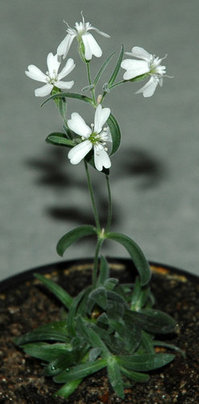“OLD DNA; A plant has been generated from the fruit of the narrow-leafed campion. It is the oldest plant by far to be grown from ancient tissue.” Source of caption and photo: online version of the NYT article quoted and cited below.
(p. D1) Living plants have been generated from the fruit of a little arctic flower, the narrow-leafed campion, that died 32,000 years ago, a team of Russian scientists reports. The fruit was stored by an arctic ground squirrel in its burrow on the tundra of northeastern Siberia and lay permanently frozen until excavated by scientists a few years ago.
This would be the oldest plant by far that has ever been grown from ancient tissue. The present record is held by a date palm grown from a seed some 2,000 years old that was recovered from the ancient fortress of Masada in Israel.
Seeds and certain cells can last a long term under the right conditions, but many claims of extreme longevity have failed on closer examination, and biologists are likely to greet this claim, too, with reserve until it can be independently confirmed. Tales of wheat grown from seeds in the tombs of the pharaohs have long been discredited. Lupines were germinated from seeds in a 10,000-year-old lemming burrow found by a gold miner in the Yukon. But the seeds, later dated by the radiocarbon method, turned out to be modern contaminants.
. . .
The new report is by a team led by Svetlana Yashina and David Gilichinsky of the Russian Academy of Sciences research center at Pushchino, near Moscow, and appears in Tuesday’s issue of The Proceedings of the National Academy of Sciences of the United States of America.
“This is an amazing breakthrough,” said Grant Zazula of the Yukon Paleontology Program at Whitehorse in Yukon Territory, Canada. “I have no (p. D4) doubt in my mind that this is a legitimate claim.” It was Dr. Zazula who showed that the apparently ancient lupine seeds found by the Yukon gold miner were in fact modern.
For the full story, see:
NICHOLAS WADE. “Dead for 32,000 Years, an Arctic Plant Is Revived.” The New York Times (Tues., February 21, 2012): D1 & D4.
(Note: ellipsis added.)
(Note: the online version of the review is dated February 20, 2012.)


